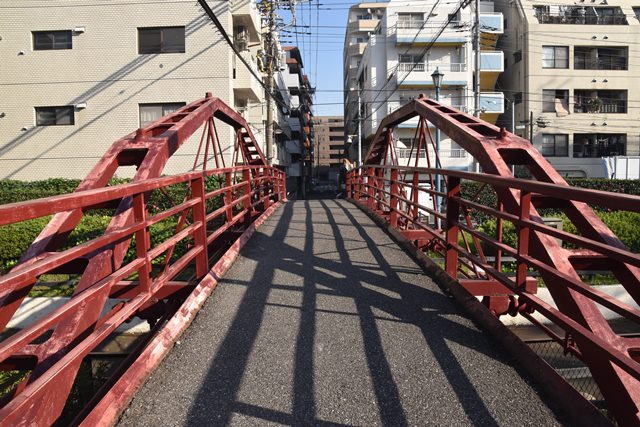We Recommend:
Bach Steel - Experts at historic truss bridge restoration.
八幡橋 (Hachiman Bridge) (はちまんばし)
弾正橋 (Danjo Bridge)

Primary Photographer(s): Nathan Holth
Bridge Documented: November 21, 2018
Tokyo (東京): Kōtō (江東区), Tokyo (東京): Japan (日本)
1878 By Builder/Contractor: Akabane Plant of the Ministry of Engineering and Engineer/Design: Squire Whipple and Shoichiro Matsumoto (松本荘一郎)
1965
47.5 Feet (14.5 Meters)
51.7 Feet (15.8 Meters)
6.6 Feet (2.01 Meters)
1 Main Span(s)
Not Applicable

View Information About HSR Ratings
Bridge Documentation
This is the oldest iron bridge in Japan and the only known surviving overseas example of a Whipple arch bowstring bridge. For both these reasons it is one of the most important historic bridges in Japan. The bridge was moved to this location in 1929, and rehabilitated with a steel deck in 1965.
An interpretive sign at the bridge was translated by Google as follows:
Nationally designated important cultural property (building) Shikijobashi Tabata Masahashi (Hachimanbashi) 1-19 to Kuni Yoseoka June 27, 1972 The 7th designated Hachimanbashi was built in Tokyo. There is an iron bridge P. It takes the form of a length of 15 meters, a plum width of 2 meters, and Hirokugu Archizaki. The arch is made of cast iron and connects five straight materials, and the other tensile material is a wrought iron casting-mixture bridge. It was originally operated by Itagawa in Kyobashi Ward (Nakarai Ward). For details on South Korea, see Yakagebashi Shimbashi History. This bridge was manufactured at the Akabane Plant of the Ministry of Engineering at the request of Tokyo Prefecture in 1878. At first, it was called "Masamashi Bridge", but it was renamed "Masamashi Bridge", because a new Amashi Bridge was built by the city block revision in 1931. Furthermore, it was abandoned due to the Teito Kikou plan after the Great East Japan Earthquake, and it was relocated to its current location in 1992. Since it was a rich and well-equipped eastern descent, it was named after Yawatabashi. It is one of the oldest existing iron bridges and is also famous for having a chrysanthemum crest. As a steel bridge during the transition from the dedicated iron bridge to the wrought iron bridge, it is a valuable bridge in the history of modern bridges and is constructed using a unique structural method, which is a valuable bridge in technical history Koto Ward Education Committee Meeting
Another interpretive sign at the bridge was translated by Google as follows:
Tokyo Famous Government Building (34th year of the Meiji era) Hachimanbashi (formerly Amashibashi) The Hachimanbashi was built on the maple river in Kyobashi Ward in 1878 (1878). Was called. It is located near the current 3-chome Takaracho, Chuo-ku. Danjobashi is one of the main streets connecting Babamon and Honjo Fukagawa, and was bridged as a symbol of the flowering of civilization. However, in 1929 (Showa 4), it was relocated to its present location, giving up its history, and the name was changed to Yawatabashi. Currently, Koto Ward is carefully preserved. This Tokyo Famous Place (current status of Mitsuhashi) depicts the Shoshobashi (back left) around 1901 (Meiji 34), and recalls the scene at that time. It is called "Mitsu-ku" together with the "Banshobashi Shiraoibashi and Shinfukujibashi," and has been popular and popular since ancient times.
Above: Shoichiro Matsumoto (松本荘一郎)
![]()
Photo Galleries and Videos: 八幡橋 (Hachiman Bridge) (はちまんばし)
Bridge Photo-Documentation
Original / Full Size PhotosA collection of overview and detail photos. This gallery offers photos in the highest available resolution and file size in a touch-friendly popup viewer.
Alternatively, Browse Without Using Viewer
![]()
Bridge Photo-Documentation
Mobile Optimized PhotosA collection of overview and detail photos. This gallery features data-friendly, fast-loading photos in a touch-friendly popup viewer.
Alternatively, Browse Without Using Viewer
![]()
Maps and Links: 八幡橋 (Hachiman Bridge) (はちまんばし)
Coordinates (Latitude, Longitude):
Search For Additional Bridge Listings:
Additional Maps:
Google Streetview (If Available)
GeoHack (Additional Links and Coordinates)
Apple Maps (Via DuckDuckGo Search)
Apple Maps (Apple devices only)
Android: Open Location In Your Map or GPS App
Flickr Gallery (Find Nearby Photos)
Wikimedia Commons (Find Nearby Photos)
Directions Via Sygic For Android
Directions Via Sygic For iOS and Android Dolphin Browser



